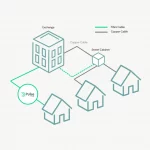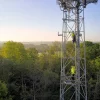Maldon District Council May Pull Out of Essex UK Broadband Project
Trouble seems to be brewing in Maldon after councillors on the District Council’s Finance Committee were said to have voted unanimously to ask the full council to scrap its deal for helping to fund the roll-out of “superfast broadband” with Essex County Council, which would have contributed £45,000 to the effort.
At present the primary state aid fuelled Superfast Essex scheme, which is supported by Openreach (BT), Gigaclear and the Government’s Broadband Delivery UK programme, is working to extend “superfast broadband” (24Mbps+) coverage to around 97% of the county by December 2019 (currently 93%+). After that the project also hopes to get as close to 100% coverage as possible by 2021.
However Maldon alone has been trailing behind and the district council’s Finance Committee recently reported that only 81.5% of the area now has access to a “superfast broadband” network (official data from August 2018), although this is up from just 38% of premises in 2013.
Advertisement
As part of the £45,000 Phase 2a roll-out deal (due to be paid over three years for the duration of the contract), which was agreed in May 2016, Maldon should see coverage rise to 92% and most of that will be via Openreach’s up to 80Mbps capable Fibre-to-the-Cabinet (FTTC) technology.
Sadly councillors on the Finance Committee appear to have grown frustrated with both the progress and the use of public money. According to the Maldon Standard, the committee has now proposed to scrap the deal and thus renege on a long established agreement.
The reasoning for all this seems to vary. For example, Council Leader Adrian Fluker thinks that “BT will roll this out whether they have our money or not” (i.e. shifting investment responsibility back to Essex council). Meanwhile the Heybridge East representative, Bryan Harker, suggested that “if you live out in the sticks that is a lifestyle choice and taxpayers money should not be spent” (hard luck if you were born there!). Not forgetting that a fair few of those in the final 15-20% of premises do not “live out in the sticks” (i.e. it’s not only an issue for remote rural areas).
Harker also noted that in Heybridge they were promised “24Mbps but in your dreams – there is only 15Mbps where I am. It is smoke and mirrors,” which seems more likely to be a reflection of that age old confusion between total raw FTTC network coverage and the different reach of “superfast” speeds within that network. Some areas covered by FTTC do receive sub-24Mbps but this is often improved via later phases, while the superfast % coverage figures from BDUK only represent those areas that are actually estimated to receive 24Mbps+ (i.e. sub-24Mbps FTTC coverage is excluded).
Advertisement
Kevin Bentley, Essex County Hall Infrastructure Boss, said:
“I am hugely disappointed to hear that the committee is recommending a proposal to withdraw Maldon District Council’s funding contribution from the Superfast Essex programme.
Five other districts in Essex are contributing considerable funds towards additional local coverage and have received match funding from Government as a result which has doubled the benefit for their residents and businesses.
If Maldon District Council does decide to withdraw these funds it would be pulling out of a firm agreement which was made two years ago. This will force Essex County Council to cut back the planned rollout of superfast broadband in Maldon district which will be a real shame for residents and businesses in this part of the county.”
After a bit of digging we managed to unearth the related agenda document for the aforementioned meeting of the Finance Committee (here), which adds the following context. The originally proposed solution is also rather different from what has now reportedly been voted through.
Finance Committee Conclusion
While coverage levels in Maldon District are currently at 81.5%, according to Superfast Essex figures, reports received from businesses indicate that expected broadband speeds may not be experienced in the field. We are more likely to hear from dissatisfied businesses, so these views may not be representative, but we are aware of a number of potential reasons for the perception that delivery of broadband in rural areas is not meeting expectations.
Firstly, coverage figures provided by Superfast Essex do not guarantee that full speeds are being experienced across the area technically covered. Superfast broadband is provided by FTTC technology with fibre optic cables to specific points (cabinets, colloquially referred to as green boxes). Connections from cabinets to homes and businesses are provided by conventional copper wires. Broadband speeds drop significantly when transmitted over copper wire and the effect is magnified over greater distances. The cabinets also have a maximum capacity, so not all customers may be connected if the demand outstrips the available supply. Finally, the customers have to opt in to the faster broadband service and this may be provided at additional cost, so not all customers take up the available faster service.
Subject to the provision of the funding agreement by Essex County Council, and based on the resolution of the Council, MDC should therefore conclude an agreement with Superfast Essex in the form of a bilateral funding agreement to cover the delivery of Phase 2a in Maldon District with payment on meeting suitable delivery targets.
It’s worth noting that across the UK only around 4% of Openreach’s FTTC (VDSL2) based “fibre broadband” street cabinets are full to capacity and those issues are usually (so we are told) resolved within the space of a few weeks or months. Sadly a few areas may have to wait a lot longer but that’s rare (e.g. if much more expensive and complicated civil engineering work is required).
The issue of variable FTTC speeds is one we’ve touched on earlier, although as above the official estimates for “superfast” coverage do take into account the technology’s shortcomings and predicted reach vs performance. Mind you even those estimates have limits and there’s no accounting for external issues, such as poor home wiring or slow WiFi, which can also affect the end-users experience.
A final decision is due to be voted on in November 2018, at the next full council meeting in Maldon.
Advertisement
Mark is a professional technology writer, IT consultant and computer engineer from Dorset (England), he also founded ISPreview in 1999 and enjoys analysing the latest telecoms and broadband developments. Find me on X (Twitter), Mastodon, Facebook, BlueSky, Threads.net and Linkedin.
« KCOM Boss Hints at Lower Broadband Prices and New Router
Three UK Quietly Removes Tethering Caps from 4G Mobile Plans »
















































Comments are closed